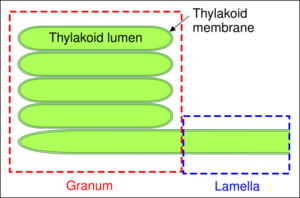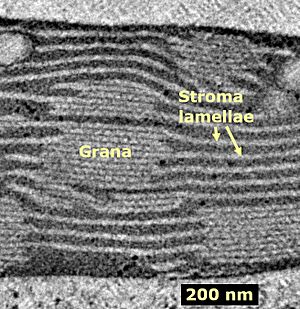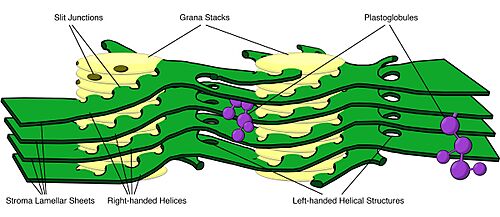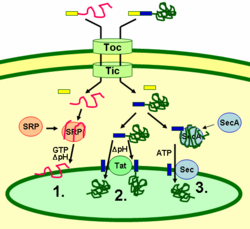Thylakoid facts for kids
Thylakoids are tiny compartments found inside chloroplasts (in plants) and cyanobacteria (a type of bacteria). They are super important because this is where the first part of photosynthesis happens. Photosynthesis is how plants and some bacteria make their own food using sunlight.
Each thylakoid has a special outer layer called a thylakoid membrane and a space inside called a thylakoid lumen. In plant chloroplasts, thylakoids often stack up like coins, forming structures called grana (one stack is a granum). These stacks are connected by other thylakoids, making one big working system.
Inside the thylakoid membranes, there are tiny packets called quantasomes. These packets hold the chlorophyll pigments, which are the green stuff that captures sunlight. Each packet has about 230 to 250 chlorophyll molecules.
Contents
What Does "Thylakoid" Mean?
The word Thylakoid comes from the Greek word thylakos. This word means "sac" or "pouch". So, thylakoid simply means "sac-like" or "pouch-like".
How Thylakoids Are Built
Thylakoids are structures surrounded by a membrane. They are found within the stroma, which is the fluid inside a chloroplast. When thylakoids stack up, they form a granum, which looks a lot like a stack of coins.
The Thylakoid Membrane
The thylakoid membrane is where the light-dependent reactions of photosynthesis take place. This is because the special pigments that capture light are right inside this membrane. The membrane is made of dark and light layers, each about 1 nanometre thick.
The thylakoid membrane is similar to membranes found in bacteria and the inner membrane of chloroplasts. For example, it contains special fats called acidic lipids. These lipids are important for the parts of photosynthesis that capture light. The membranes in plants are mostly made of other types of fats called phospholipids and galactolipids. These fats are arranged in a specific way.
The Thylakoid Lumen
The thylakoid lumen is the watery space inside the thylakoid membrane. It plays a very important role in making energy during photosynthesis. During the light-dependent reactions, tiny particles called protons are pumped from the outside of the thylakoid into the lumen. This makes the lumen very acidic, like a strong acid, with a pH of about 4.
Grana and Stroma Thylakoids
In plants, thylakoids are organized into stacks called grana. A granum (plural grana) is a stack of thylakoid discs. A chloroplast can have anywhere from 10 to 100 grana.
Grana are connected by other thylakoids called stroma thylakoids, also known as lamellae. Grana thylakoids and stroma thylakoids have different proteins. Grana help chloroplasts have a large surface area, which is important for photosynthesis.
Scientists have studied these membranes closely. They found that the stroma lamellae are arranged in wide sheets that connect the grana stacks. This creates a complex network that helps the membranes stay stable and work well.
How Thylakoids Form
Chloroplasts grow from smaller structures called proplastids when plant seedlings start to grow out of the ground. Thylakoids need light to form properly.
If a plant embryo is in the dark, its proplastids turn into etioplasts. These etioplasts have special membrane structures called prolamellar bodies. When these etioplasts are exposed to light, the prolamellar bodies develop into thylakoids. If seedlings grow in the dark, they become pale and stretched, a process called etiolation, and their thylakoids won't form correctly. Not enough light can cause thylakoids to fail, which means the chloroplasts fail, and the plant can die.
A protein called vesicle-inducing protein in plastids 1 (VIPP1) is needed for thylakoid formation. Plants cannot live without this protein. If a plant has low levels of VIPP1, it grows slower and looks paler because it can't photosynthesize well. VIPP1 seems to be essential for building the basic thylakoid membrane. This protein is found in all organisms that have thylakoids, including cyanobacteria and plants like Arabidopsis thaliana.
Proteins in Thylakoids
Thylakoids contain many proteins that are either part of the membrane or attached to it. Recent studies have shown that thylakoids have at least 335 different proteins. About 42% of these proteins are involved in photosynthesis. Other proteins help with things like moving proteins, processing them, and protecting the cell from stress.
Proteins Inside the Membrane
Thylakoid membranes contain proteins that are crucial for capturing light and for the light-dependent reactions of photosynthesis. There are four main protein groups in the thylakoid membrane:
- Photosystems I and II
- Cytochrome b6f complex
- ATP synthase
Photosystem II is mostly found in the grana thylakoids. Photosystem I and ATP synthase are mostly in the stroma thylakoids and the outer parts of grana. The cytochrome b6f complex is spread out evenly. Because these photosystems are in different places, tiny mobile carriers are needed to move electrons between them. These carriers are plastoquinone and plastocyanin. Plastoquinone moves electrons from photosystem II to the cytochrome b6f complex. Plastocyanin carries electrons from the cytochrome b6f complex to photosystem I.
Together, these proteins use light energy to power chains that move electrons. This creates a special energy difference across the thylakoid membrane and produces NADPH. The ATP synthase then uses this energy difference to make ATP during photophosphorylation.
Photosystems
Photosystems are like light-powered centers that start the electron movement. Each photosystem has an "antenna" that uses chlorophyll and other pigments (like carotenoids) to collect light energy. This energy is then sent to a special chlorophyll molecule at the center of each photosystem.
When these chlorophyll molecules absorb energy, an electron gets excited and moves to another molecule.
- Photosystem I has a pair of chlorophyll molecules called P700. They absorb light best at 700 nanometers (deep red light).
- Photosystem II has P680 chlorophyll, which absorbs light best at 680 nanometers (also deep red light).
The "P" stands for pigment, and the number is the best wavelength of light they absorb. This is the green pigment in plants that we can't see with our eyes.
Cytochrome b6f Complex
The cytochrome b6f complex is part of the electron transport chain in the thylakoid. It helps move electrons and pumps protons into the thylakoid lumen. It sits between the two photosystems and moves electrons from photosystem II to photosystem I.
ATP Synthase
The thylakoid ATP synthase is a protein that makes ATP. It is built into the thylakoid membrane, with part of it sticking into the stroma. This means ATP is made on the stroma side of the thylakoids, which is where the ATP is needed for the light-independent reactions of photosynthesis.
Proteins Inside the Lumen
The electron transport protein plastocyanin is found in the lumen. It moves electrons from the cytochrome b6f protein complex to photosystem I. While plastoquinones move within the thylakoid membrane, plastocyanin moves through the watery space of the thylakoid lumen.
The lumen is also where water is split by the oxygen evolving complex. This complex is connected to photosystem II on the lumen side.
How Proteins Get to Thylakoids
Proteins that work in thylakoids have special "address labels" that tell them where to go. Most thylakoid proteins made by the plant's main cell nucleus need two of these labels. They first enter the chloroplast, then the first label is removed. This reveals the second label, which guides the protein from the stroma into the thylakoid. This second step needs energy.
Proteins can be put into the membrane in different ways, or they can be moved into the lumen. These different pathways use different signals and energy sources.
What Thylakoids Do
Thylakoids are where the light-dependent reactions of photosynthesis happen. These reactions include:
- Splitting water using light energy, which releases oxygen.
- Pumping protons across the thylakoid membranes. This is linked to the electron transport chain of the photosystems and cytochrome complex.
- Making ATP using the energy from the proton gradient.
Splitting Water with Light
The first step in photosynthesis is using light to split water. This provides electrons for the electron transport chains and protons for creating an energy difference. This water-splitting happens inside the thylakoid lumen. It also produces oxygen (O2), which is a waste product for the plant but vital for cellular respiration in animals and humans. The oxygen is released into the air.
Electron Transport Chains
There are two ways electrons are moved during photosynthesis:
- Noncyclic electron transport: This process makes both NADPH and ATP. It uses both photosystems.
- Cyclic electron transport: This process only makes ATP. It only uses photosystem I.
Photosystem I uses light energy to change NADP+ into NADPH. It works in both noncyclic and cyclic electron transport. In cyclic mode, the energized electron goes through a chain and then returns to the chlorophyll that energized it.
Photosystem II uses light energy to split water molecules. This produces electrons, protons, and oxygen. It only works in noncyclic transport. In this system, new electrons constantly come from the split water, and they leave when NADP+ is changed into NADPH.
Making Energy with Chemiosmosis
A main job of the thylakoid membrane and its photosystems is to create a special energy difference called chemiosmotic potential. The carriers in the electron transport chain use some of the electron's energy to actively move protons from the stroma (outside the thylakoid) into the lumen (inside the thylakoid).
During photosynthesis, the lumen becomes very acidic, with a pH as low as 4. The stroma has a pH of about 8. This means there are 10,000 times more protons inside the lumen than outside! This huge difference is a strong energy source.
Where the Protons Come From
The protons inside the lumen come from three main places:
- When photosystem II splits water, it releases protons into the lumen.
- When electrons move from photosystem II to plastoquinone, two protons are taken from the stroma. These protons are then released into the lumen when the plastoquinol is processed by the cytochrome b6f complex.
- When plastoquinone is changed by ferredoxin during cyclic electron transport, two more protons are moved from the stroma to the lumen.
The proton difference also happens because protons are used up in the stroma to make NADPH from NADP+.
How ATP is Made
The way ATP (Adenosine triphosphate) is made in chloroplasts is similar to how it's made in mitochondria. It uses the energy from the proton difference, called the proton motive force (PMF). Chloroplasts rely more on the chemical part of this PMF to make the energy needed for ATP synthesis.
The PMF is made of two parts: the proton concentration difference and an electrical difference across the membrane. Unlike mitochondria, thylakoid membranes don't have a big electrical difference. To make up for this, the proton concentration difference across the thylakoid membrane is much, much higher (10,000 times) compared to mitochondria.
This strong energy difference between the lumen and the stroma is enough to power ATP synthesis using the ATP synthase. As protons flow back down their concentration gradient through channels in ATP synthase, ADP and phosphate are combined to make ATP. This is how the light-dependent reactions are connected to making ATP.
Thylakoid Membranes in Cyanobacteria
Cyanobacteria are a type of bacteria that can do photosynthesis. They have a complex system of internal thylakoid membranes. These membranes are where both photosynthesis and respiration happen. Having different membrane systems makes these bacteria very unique and complex.
Unlike the thylakoids in plants, which form grana stacks, cyanobacteria thylakoids are arranged in many layers that connect and split. This creates a continuous network that encloses a single lumen, just like in plant chloroplasts. This allows molecules to move easily throughout the entire membrane network. There are often holes in these membranes, which allow things like ribosomes and glycogen to move around the cell. The space between the thylakoids is also where the light-harvesting antennae, called phycobilisomes, are located. This structure can change a bit when the environment changes.
See also
 In Spanish: Tilacoide para niños
In Spanish: Tilacoide para niños
- Arthur Meyer (botanist)
- André Jagendorf
- Chemiosmosis
- Electrochemical gradient
- Endosymbiosis
- Oxygen evolution
- Photosynthesis








